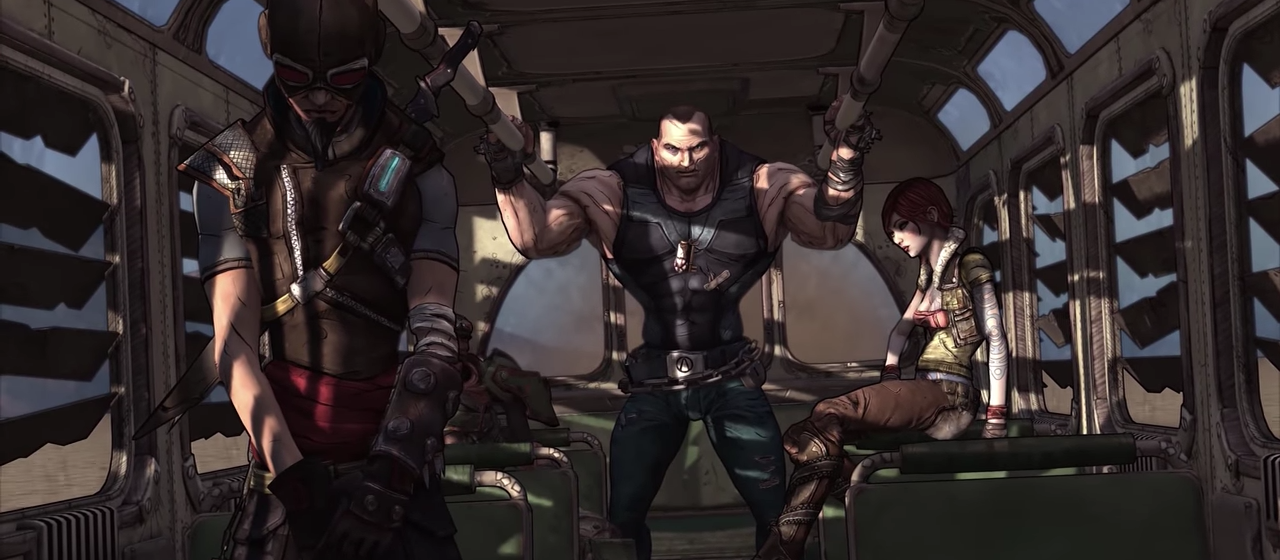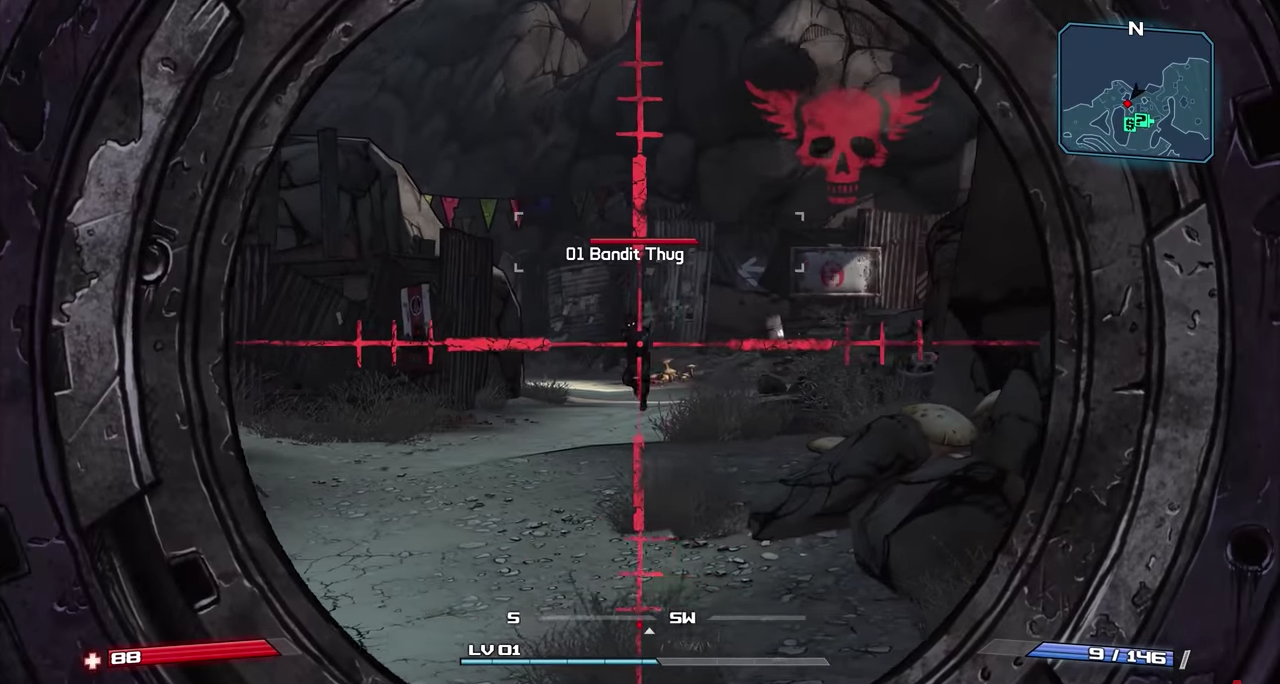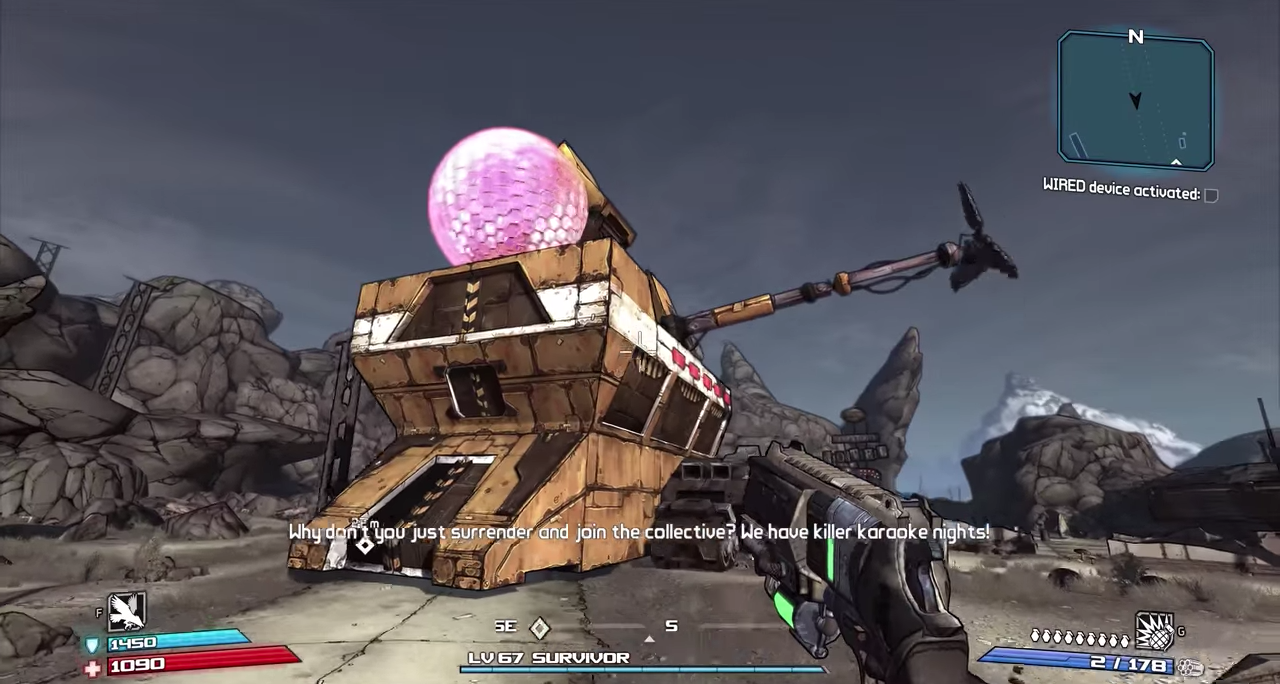

“So you want to hear a story, eh? One about treasure hunters?”
Borderlands is a daring game, and one that has aged fairly well due to its addictive loot system, outrageous sense of humor, over-the-top weapons, and cel-shaded graphical style. Released into a market of gritty military shooters (thanks to the overwhelming popularity of Call of Duty 4 and the subsequent games in that series) that took themselves very seriously, Gearbox’s quirky, open world looter shooter—which essentially created the genre—combined RPG mechanics with refined gunplay and charming characters and threw the player into a world reminiscent of the Mad Max films. It’s not without its flaws, but such a bold game deserves recognition for breaking trends and starting new ones.
The game is set in some distant future where mega corps vie for control of habitable and minable planets. One of the largest, Atlas Corporation, discovered an alien vault brimming with advanced weaponry and quickly began dominating their competition. A similar vault was located on Pandora—the dusty planet where the game is set—but the harsh environment and savage wildlife that inhabit it forced Atlas to abandon their plans, after which a rival corporation colonized the planet by using convict labor. When xenoarchaeologist Patricia Tannis discovered the location of the vault, all hell broke loose. Atlas tried to kidnap her, the rival corp pulled out of the planet—taking only the wealthiest colonists with them—and abandoned the remaining populace to fend for themselves on the barren globe. The convicts were set free and formed into gangs, wreaking havoc on the remaining Pandorians who found themselves scavenging amongst the scant plant life and industrial trash that littered the planet’s surface. Now, the vault has now faded into a half-myth that draws Vault Hunters in search of glory, and from four such glory seekers the player may choose a main character.

Obviously, your main goal is to get into the Vault. But like most RPGs, true enjoyment of the game is not tied only to its main storyline, which has a severely underwhelming ending anyway (it’s also debatable if it’s an RPG at all or just a game that utilizes stats-heavy combat and inventory micromanagement). Instead, you will spend the bulk of your time exploring, interacting with a host of bizarre characters, leveling up your character, and looting increasingly more powerful and more outrageous weapons. In fact, the entirety of the game could basically be boiled down to repeatedly shooting things (people, robots, creatures) until they are dead and then stealing their belongings. But the game makes you feel good about it in a variety of ways—the actual gunplay mechanics are solid, the leveling system is addictive, and the player receives randomized loot; i.e. you’re always getting “one of a kind” items instead of a standard issue weaponry—revolvers that shoot acid-ammo, shotguns with electro-shock shells, incendiary rifle rounds, all with different attributes.

Gearbox founder (and executive producer of Borderlands) Randy Pitchford recognized that first person shooters and role-playing games had unique gameplay loops that heretofore had not been combined. He had grown up playing RPGs, drawn to their depth and gradual buildup to long term rewards. Though he was initially dismissive of shooters, the subtlety of the gameplay in Wolfenstein 3D impressed him. And when he began his career as a designer on Duke Nukem 3D1 he concluded that chaotic, fast-paced games could achieve a depth of gameplay that he hadn’t previously realized.
Contrasting the two, it is easy to see how they hit different sweet spots. The long-range goals of an RPG often take minuscule amounts of manual dexterity or quick thinking; instead, the player finds enjoyment in the slow grind of leveling their character, discovering new areas of the map, and acquiring more powerful items. In a shooter, the response is much more immediate, almost like a sport, where success hinges on the player’s ability, and you bounce back from a failure by trying the same thing a minute later. (Pitchford’s thoughts on why we enjoy video games—discussed in the interview linked at the end of this review—are very interesting, involving a lot of self-analysis and contemplation.)
Combining the two of these seemed like a great idea to Pitchford, but it was certainly a risk. To be fair, other “first person shooter” RPGs existed—Bioshock2, Prey, and a few other games all used elements of both genres—but when the creative team began development, the market was fairly bereft of any game that resembled Borderlands. Even games that came out in the interim, such as Fallout 33 and Rage, are not truly shooters in the way that Borderlands is. I suppose what I am getting at is that Borderlands does not simply use the FPS perspective for an otherwise straight RPG—it is a legitimate shooter if not a top-of-the-line one. If you aren’t familiar with the genre—if your fingers don’t have some muscle memory from playing other FPS games—you may find yourself struggling. But if you are a fan of both genres, or willing to immerse yourself in one you’re unfamiliar with, you’ll find yourself pleasantly reaping the rewards of both.

But the game is not beloved for that reason alone. In fact, I think you can enjoy the game without even realizing that those elements are combined in a novel way because the game’s aesthetic and sense of humor are also unique. Midway through production—having already settled on a design concept of “Halo4-meets-Diablo,” and key design prompts of “serious,” “retro,” “realistic,” and “gritty”—the team realized that the gameplay didn’t match the graphical style. With ridiculous monsters, witty robots, huge car jumps, and unrealistic weapons, the game was growing increasingly extravagant, which clashed with the muted color palette and efforts towards realism. With time and money constraints forcing a creative solution, chief creative officer Brian Martel had an epiphany while reviewing the game’s concept art in search of inspiration: simply use the concept art as the visual style. The idea was met with enthusiasm by publisher 2K games as well as most of the Gearbox employees who had worked on the game,5 with many offering to help update the nearly-completed game in their spare time. This choice was an off-the-wall idea, but when comparing the look of the original demo with that of the finished product, it is clear that they made a good decision; the initial graphics looked generic, while the final comic book art style is distinctive.

The graphical overhaul opened up new gameplay and narrative options as well, as any sense of “realism” was thrown out the window. A number of caricatured non-player characters were given outrageous personalities (and names like Claptrap, Sir Hammerlock, 9 Toes, Crawmerax the Invincible, Skagzilla, Mad Moxxi, and Motorhead), and the humor is pervasive and irreverent, perhaps to a degree that “comedy” should be right there on the genre line with “RPG” and “FPS.” Knowing that Pitchford began his career working on Duke Nukem 3D, and acquired the rights to the languishing-in-development Duke Nukem Forever the year after the release of Borderlands, it is easy to see that series’ sense of humor and aesthetics in the finished product of Borderlands. Risqué jokes, pop-culture references,6 and satirical takes on Hollywood tropes are peppered throughout the game, which at times veils a deep, immersive game in the guise of a cheesy one that lives and dies by its flavorful presentation alone (Duke Nukem Forever is a good example of the latter; though I liked the game more than most, it is a very shallow product, gameplay-wise).
It’s not all aces, though. The core mechanic of fight, kill, loot body, explore, discover, raid chest is one that easily sucks the player in, but if you sit back after a while and think, “Why am I still doing this?” the unfortunate answer will likely be, “I don’t know.” While the basics are done very well, and the world the player is thrown into is just oozing with flavor, the story and characters are ultimately pretty shallow, and the quests are very repetitive. Most of the missions are simply providing a reason for a player to go to a certain location for a shootout, while the characters, most of which have epic introductions, silly names, and outrageous appearances, are cardboard cutouts without any depth (it’s kind of like a B-movie in that way). The decisions one makes seem to have little impact on the game, and without any real narrative payoff the game must be carried solely by its mechanics. I won’t deny that the game is an RPG, but that aspect of the game lacks the depth of the best of that genre, and after a while the dedicated player will find themselves worn thin as play starts to feel like work.
Borderlands is one-of-a-kind (or was when it was released, at least). The gunplay is solid, the AI is mildly intelligent, and the loot collecting is effectively limitless. It doesn’t really measure up to the contemporary RPGs of its era, but it wasn’t really trying. Rather, it employs a decently immersive combat system, smothers it in goofy flavor, and calls it a day. While I enjoyed my time with Borderlands, it became so tiresome by its completion that I feel little desire to ever return to it. That said, it’s impossible to deny that it broke new ground and that many subsequent games have built upon it, and it deserves much of the retrospective praise it gets.
1. The series of both Wolfenstein and Duke Nukem transitioned into and helped popularize the FPS genre.
2. System Shock, which served as a spiritual predecessor to Bioshock as well as Deus Ex combined the elements of the two genres way back in 1994.
3. Like Duke Nukem and Wolfenstein, the Fallout series also transitioned into the FPS genre, after two games as a turn-based RPG.
4. Gearbox had ported Halo to Windows several years prior.
5. Unfortunately, the game’s original art director was so disappointed that all of her work had essentially been scrapped that she quit working at Gearbox and left the industry altogether.
6. There are references to Aliens, The Beastie Boys, 2001: A Space Odyssey, Firefly, The Godfather, Fight Club, The Hitchhiker’s Guide to the Galaxy, The Lord of the Rings, Half-life, Moby Dick, Trigun, and Pulp Fiction, among many, many others.
Sources:
Walden, Matthew. “Gearbox Software’s Randy Pitchford Talks Nintendo Switch, ‘Overwatch’ and Being Fearless”. Glixel. 25 January 2017.
Thorsen, Tor. “Behind Borderlands’ 11th-hour style change”. Gamespot. 15 March 2010.